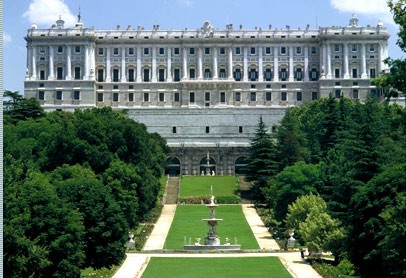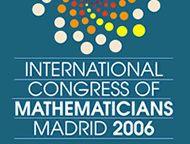Madrid
Madrid, host city of the ICM2006 is renowned for cultural tourism and leisure, history and modernity, in a lively and cosmopolitan atmosphere, with first-rate facilities and professional services.

GENERAL DATA
The capital of Spain since 1562, Madrid is located in the geographic centre of the Iberian Peninsula, at 646 metres above sea level. Because of its central location and high altitude, the climate of Madrid is characterized by warm dry summers and cool winters.
Distance between Madrid and main Spanish cities:
Toledo: 71km, Segovia: 87km, Salamanca: 200km, Valencia: 352km, Granada: 423km, Córdoba: 394km, Sevilla: 462km, Barcelona: 621km
Madrid has a population of over four million inhabitants. It is a cosmopolitan city in which the main offices of Public Administration are found, together with the seats of Government and the Spanish Parliament. It is also the main residence of the Spanish Royal Family.
Madrid also plays a major role in both Finance and Industry. Much of the industry is located in the southern part of the city, where important textile, food and metallurgical plants are concentrated.
CULTURE & MUSEUMS
Madrid is one of the major capitals of the arts. Its galleries and museums are among the finest in the world. It is necessary to set aside a significant amount of time if you want to capture the full flavour of what Madrid has to offer.
If you are unable to stop over for very long, you will almost certainly find that you have more than enough to keep you busy in Madrid's three most important museums along the “Walk of the Art”: Prado, Thyssen and Reina Sofia Museum .
These three museums are located near the city centre, all within walking distance of one another, forming what is known as the 'golden triangle'. Although it is possible to visit all three museums in a single day, those who try will no doubt end their tour with sore feet. For art lovers, a single visit to any of these three will certainly be insufficient.
Madrid is also a lively metropolis with many pubs, cafés, discotheques and nightclubs open late into the night, where you could discover for example flamenco dancing.
GASTRONOMY
Since Philip II made Madrid the capital of Spain, numerous recipes and culinary influences from all the regions of the country have been incorporated into its cuisine, so that it is practically impossible to say which dishes are original and which are imported. Today Madrid offers a more Spanish than regional type of cooking.
Typical dishes are mainly hotpots, such as the well-known Cocido Madrileño with chick-peas. Among regional specialities the delicious asparagus from Aranjuez and the very typical Sopa de Ajo - a soup made of garlic- are delicious.
There are many dishes of lamb and veal, although surprisingly considering its geographic location, Madrid is a real paradise for the lovers of all kinds of fish. It has the second biggest fish market in the world (after Tokyo), and in shops as well as in many restaurants you will find a wide selection of fish of extraordinary quality.
Ideally suited to this kind of meal are the young and aromatic wines of the region, Vinos de Madrid. To round off your dinner in a very typical way, try a glass of Anisado de Chinchón -anisette schnapps.
In addition to these specialities, “tapas“ are a venerable gastronomic tradition. Served as appetizers with wine or beer, these savoury titbits (such as Serrano ham, tortilla de patata..) are a distinctive feature in many bars and restaurants throughout the city.
2004 © Copyright by Asociación International Congress of Mathematicians, ICM
2006 Madrid. All Rights Reserved.

